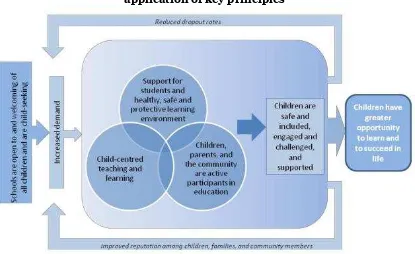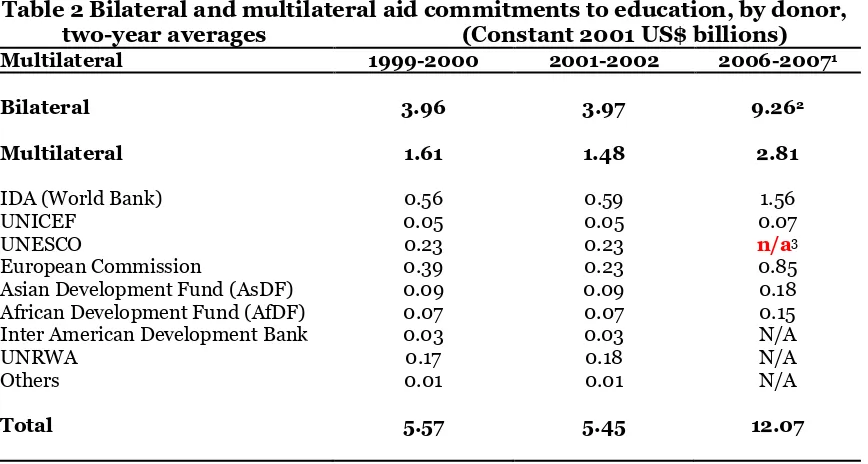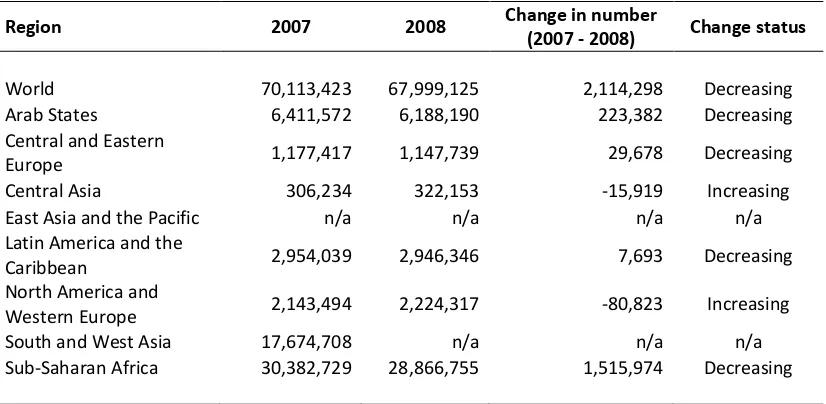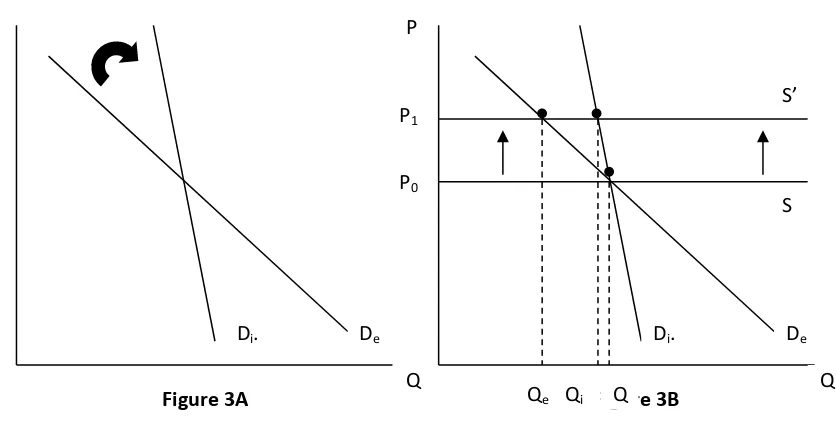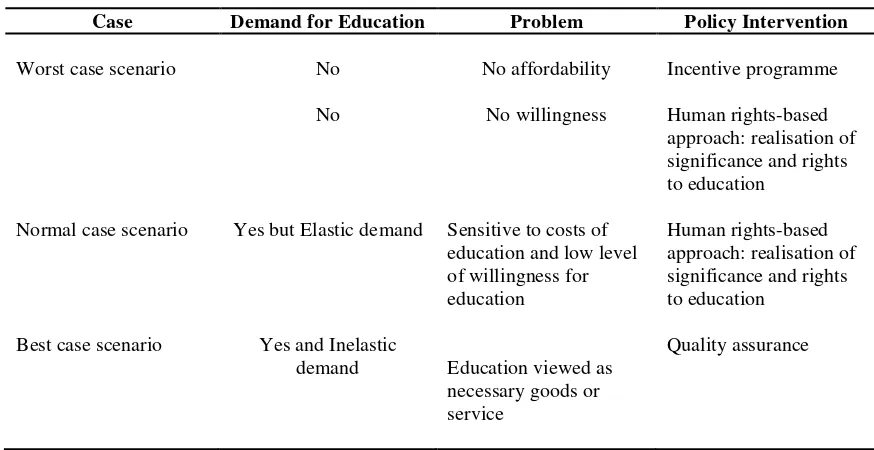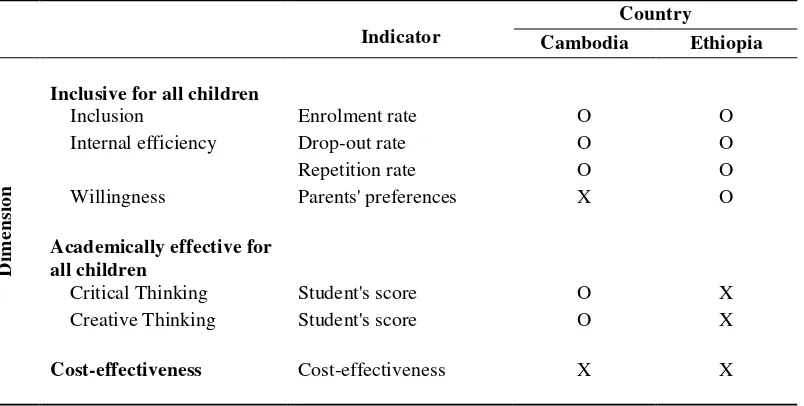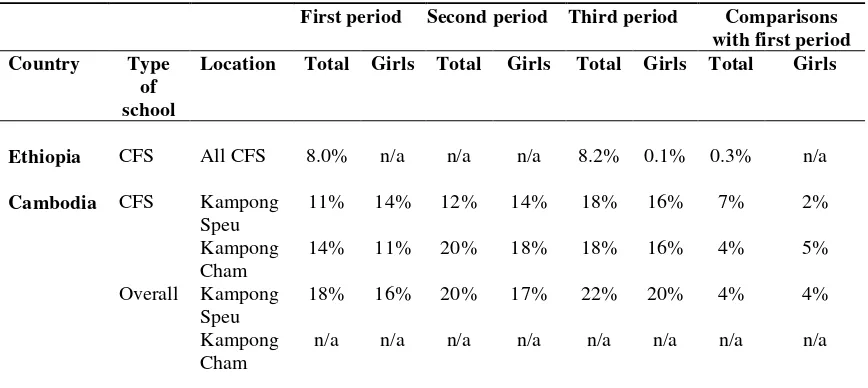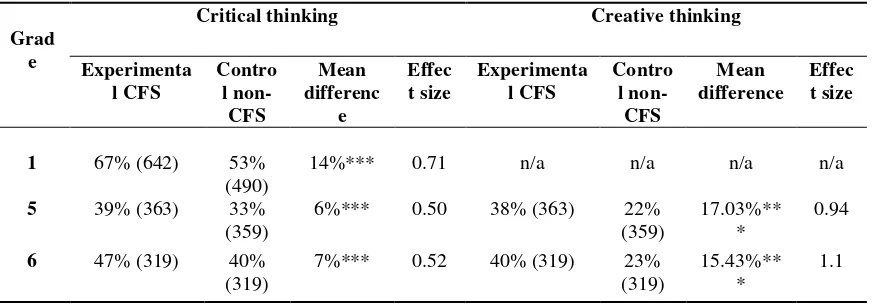UNESCO and UNICEF
’
s Human Rights-Based Approach
towards EFA goals, Economically Wise or Irrational:
Policy Analysis from Economic Perspective
Upalat Korwatanasakul
Ph.D Student Graduate School of Asia Pasific Studies Waseda University
e-mail: [email protected]
ABSTRACT
An analysis is given of UNESCO and UNICEF’s current thinking and practice in the education sector, especially on a human rights-based approach. Economically irrational policy implementation can be a result of inefficiency and ineffectiveness of resource allocation; therefore, policy assessment is necessary. Moreover, the deadline for EFA goals is approaching and it seems that EFA goals will not be met under current policy implementation by 2015. This paper bases its analysis on economic theory and offers policy implications and suggestions through a thought experiment and empirical case studies. An analysis is conducted in two levels, general perspective on education and specific aid projects/programmes. Analysing policies from economic perspective gives a new impression and dimension towards UNESCO and UNICEF. This paper argues that a human rights-based approach is economically rational and sustainable. Identifying rights-holders and duty-bearers cannot only induce demand and supply for education but also theoretically make individuals’ demand for education to be more inelastic to the prices or costs of education. However, in terms of effectiveness of project/programme investment, adjustments are required in the process of project/programme implementation. As a result, there is an ambiguous tension between theoretical and practical issues. Policy implications and suggestions are made accordingly.
Keywords: Policy analysis, Human rights-based approach, Multilateral donor agencies
Analisis dari unesco dan unicef dalam sektor pendidikan, terutama pada seorang manusia dengan pendekatan hak asasi manusia. Secara ekonomi irasional pelaksanaan kebijakan dapat diakibatkan dari inefisiensi dan tidak efektifnya alokasi sumber daya; karena itu, penilaian kebijakan diperlukan. Selain itu, batas akhir bagi tujuan EFA adalah mendatangi dan tampaknya EFA tidak akan terpenuhi di bawah gol kebijakan saat ini pelaksanaannya sampai dengan 2015. Artikel ini mengajukan analisis mengenai teori ekonomi dan menawarkan implikasi kebijakan kajian ini dan saran melalui sebuah percobaan pikiran dan studi kasus empiris. Analisis dilakukan dalam dua tingkat, persepsi terhadap umum pendidikan dan spesifik program-program proyek bantuan. Yang menganalisis kebijakan dari perspektif perekonomian memberikan masukan baru dan dimensi baru terhadap kebijakan UNESCO dan UNICEF
Introduction
This research examines UNESCO and UNICEF’s current thinking and practice in the education sector, especially on a human rights-based approach towards education for all (EFA) goals, through the lens of economic analysis in order to indicate whether this approach is aligned with economic rationales and what conditions should be satisfied if their policies appear not to be rational in economist’s point of view. Irrational policy direction in economic sense can be a result of inefficiency and ineffectiveness of resource allocation. Furthermore, the deadline for EFA goals is approaching and it seems that EFA goals will not be met under current policy implementations by 2015; therefore, there is a need for policy assessment. Evaluating the advantages and disadvantages of policy implementations can help policymakers design policy measures to achieve EFA goals more efficiently and effectively. An analysis is conducted in two levels, including general perspective on education and specific aid projects/programmes. The tensions and complements between education for development and education as a human right are also analysed. This paper is not empirical research per se as it bases its analysis on economic theories and provides policy implications and suggestions through a thought experiment. However, case studies are used to provide some empirical evidences on the effectiveness of project/programme implementation in the second level of the analysis.
Human Rights-Based Approach
A human rights-based approach (OHCHR, 2006) is, “a conceptual framework for the process of human development that is normatively based on international human rights standards and operationally directed to promoting and protecting human rights”. It aims to analyse social issues impeding development progress, namely inequalities, discriminatory practices and unjust distributions of power. The goal of a human rights-based approach to education is, “to assure every child a quality education that respects and promotes her or his right to dignity and optimum development” (OHCHR, 2006). Agreed upon by United Nations agencies, a human rights-based approach has two main features, implementing policies and programmes concerning human rights and identifying rights-holders and duty-bearers accordingly.
A conceptual framework for the rights-based approach to education must satisfy all three interdependent dimensions in order to make human rights related to education realised (OHCHR, 2006). The first dimension is the right of access to education; every child must be assured that they have access to education without any discriminatory practices. The right to quality education is considered as a second dimension which education must be designed and provided based on children`s need, child-centred basis, so as to make them realise their potential and opportunities in labour market and develop life skills. The last dimension is the right to respect within the learning environment; it is the reiteration of the ultimate goal which every child has an access to the education system which respects and promotes her or his right to dignity.
supply-sided intervention are school and infrastructure building project, teacher`s capacity building, financial aid to education sector, to name a few.
Child Friendly School (CFS)
UNICEF introduced the Child Friendly School (CFS) project in 1999 and based this framework in the 1990 Convention on the Rights of the Child’s principles of children’s rights. CFS consists of three key and inter-related principles with six dimensions. UNICEF (2009) implements CFS models through the application of three principles, namely child-centredness, democratic participation and inclusiveness (Figure 1). With these principles, UNICEF’s movement is safeguarding the interest of child; guaranteeing the rights for all children; and ensuring all children have an access to the education. CFS is UNICEF’s flagship education programme applying the human rights-based approach to achieve the ultimate goals which all children have an access to quality education with a proper and supportive environment.
According to Bernard (2005&2008), six dimensions of CFS includes inclusive for all children; academically effective for all children; healthy for/protective of all children; gender-equality assured for all children; involvement of children, parents, community; and a CFS-enabling environment. Inclusive for all children ensures that all children have access to the quality of education without any discrimination and emphasizes on marginalised groups. Second dimension focuses on the quality of the education in order to be relevant to children`s needs. Then, both psychological and physiological conditions of children are taken into consideration in the third dimension, healthy for/protective of all children. Furthermore, gender equality and community involvement are emphasized in fourth and fifth dimensions, respectively. Finally, the most important dimension, a CFS-enabling environment is supported through enabling policies, methods, and guidelines to more effectively utilize available structures and resources.
Figure 1CFS model as a pathway to quality education through the application of key principles
EFA and Its Main Actors
The Education for All (EFA) movement is a global commitment to provide quality basic education for all children, youth and adults. At the World Education Forum (Dakar, 2000), 164 governments pledged to achieve EFA and identified six goals (Table 1) to be met by 2015. Governments, development agencies, civil society and the private sector are working together to reach the EFA goals (UNESCO, 2002). The Dakar Framework for Action mandated UNESCO as the leading agency to coordinate these partners, in cooperation with the four other convenors of the Dakar Forum (UNDP, UNFPA, UNICEF and the World Bank). This section discusses function, perspective on education and contribution of three main actors, including UNESCO, UNICEF and the World Bank, in general and towards EFA.
Table 1 Six EFA goals Goal 1
Goal 2
Goal 3
Goal 4
Goal 5
Goal 6
Expanding and improving comprehensive early childhood care and education, especially for the most vulnerable and disadvantaged children
Ensuring that by 2015 all children, particularly girls, children in difficult circumstances and those belonging to ethnic minorities, have access to, and complete, free and compulsory primary education of good quality.
Ensuring that the learning needs of all young people and adults are met through equitable access to appropriate learning and life-skills programmes
Achieving a 50 per cent improvement in levels of adult literacy by 2015, especially for women, and equitable access to basic and continuing education for all adults.
Eliminating gender disparities in primary and secondary education by 2005, and achieving gender equality in education by 2015, with a focus on ensuring girls’ full and equal access to and achievement in basic education of good quality.
Improving all aspects of the quality of education and ensuring excellence of all so that recognized and measurable learning outcomes are achieved by all, especially in literacy, numeracy and essential life skills.
Source: UNESCO, 2002
Mission and Function
1) The World Bank
The World Bank (World Bank, 2011) is a vital source of financial and technical assistance to developing countries around the world. It provides low-interest loans, interest-free credits and grants to developing countries for a wide array of purposes that include investments in education, health, public administration, infrastructure, financial and private sector development, agriculture and environmental and natural resource management. The World Bank is made up of two unique development institutions owned by 187 member countries: the International Bank for Reconstruction and Development (IBRD) and the International Development Association (IDA). Each institution plays a different but collaborative role in advancing the vision of inclusive and sustainable globalization. The IBRD aims to reduce poverty in middle-income and creditworthy poorer countries, while IDA focuses on the world's poorest countries.
poverty, all of which are at the heart of UNESCO’S mission and activities. UNESCO’s mission is to contribute to the building of peace, the eradication of poverty, sustainable development and intercultural dialogue through education, the sciences, culture, communication and information. The Organization focuses, in particular, on two global priorities, namely Africa and Gender equality.
3) United Nations Children’s Fund (UNICEF)
UNICEF was created by the United Nations General Assembly and assigned to provide emergency food and healthcare to children in countries suffered from World War II. Currently, it has been “the driving force that helps build a world where the rights of every child are realized” (UNICEF 2011). UNICEF strongly believes that nurturing and caring for children are the cornerstones of human progress; therefore, with this purpose in mind UNICEF is working to work with other partners to overcome the obstacles that poverty, violence, disease and discrimination place in a child’s path. Perspective on Education
According to statement and mission, it is clear that each institution has different perspectives on education. The World Bank (2011) put heavy emphasis on education for development as it states that, “Education is universally recognized as a fundamental building block for human development … and is a powerful driver for development of individuals and society … For this reason, it is at the center of the World Bank’s mission for a world free of poverty.” With different perspective on education, UNESCO, however, treats education as an instrument for international/intercultural understanding and social cohesion. According to UNESCO Constitution (1945), the states parties declared that, “That since wars begin in the minds of men, it is in the minds of men that the defences of peace must be constructed; That ignorance of each other’s ways and lives has been a common cause, throughout the history of mankind, of that suspicion and mistrust between the peoples of the world through which their differences have all too often broken into war.” This statement conveys a strong message and lucid position of UNESCO on how it views the world and its stand in approaching problems and issues. Finally, UNICEF (2011) clearly positions itself as a human-right based organisation and considers education as a human right; “Education is a fundamental human right: ... When we ensure that children have access to a rights-based, quality education that is rooted in gender equality, we create a ripple effect of opportunity that impacts generations to come.” These differences of perspective on education imply that each institution is approaching problems on education in different ways with different policy directions as they possess different norms and values and view the world from different angles.
Recently, there is a convergence between UNESCO and UNICEF’s perspectives on education which a human rights-based approach is promoted to be a core of framework for development policy, including educational policy (OHCHR, 2006; UNESCO & UNICEF, 2007). This movement is reflected on the joint UNICEF-UNESCO publication, A Human Rights-Based Approach to Education for All (2007). Thus, UNESCO and UNICEF’s perspectives on education can be treated and analysed as one perspective, education as a human right. The tensions and complements occur between two main perspectives, education for development (economics-oriented and positive approach) and education as a human right (socio-cultural and normative approach).
Financial Contribution on EFA
individually 2 billion US dollar in 2006-2007. Ironically, UNESCO does not report its own contribution intentionally or unintentionally in 2006-2007 in EFA Global Monitoring Report 2010, while it heavily criticises other donors on the relatively small contribution compared to significant contributors, including France, Germany, the Netherlands, the United Kingdom and the World Bank’s International Development Association (IDA) (UNESCO, 2010).
Table 2 Bilateral and multilateral aid commitments to education, by donor, two-year averages (Constant 2001 US$ billions)
Multilateral 1999-2000 2001-2002 2006-20071
Bilateral
2 Bilateral component might not include the same set of countries 3 n/a: Not available
Source: UNESCO, 2005 & 2010
Literature Review
Previous studies (e.g. Lauglo, 1996; Bennell, 1996; Watson, 1999; Mundy, 1999) criticise on multilateral donor agencies’ policy directions from different perspectives. Typical arguments which can be found often are socio-cultural insensitiveness and empirical weakness of policy. Table 3 provides a brief overall picture of each institution’s strengths and weaknesses.
First, the World Bank is usually accused as a socio-cultural insensitive and money-oriented organisation since its policies are based on economic analysis, for example, rate of return, cost effectiveness, to name a few, in which scholars or non-scholars who do not possess profound knowledge of economics tend to believe that economist oversimplifies the problems with a set of certain assumptions and only consider financial returns. Lauglo (1996) gives critiques to the World Bank on the World Bank’s 1995 policy review on education on several aspects, including its assumptions about the benefit of schooling; its policy implementation on basic education and vocational education; and the reliance on rate-of-return analysis. It is found that the most typical critique on the World Bank is heavy use of the rate of return to education analysis (RORE). The reliability and generalisability of RORE have been questioned (Bennell, 1996). In response to critiques, Burnett and Patrinos (1996), the World Bank’s staffs, states that, “In conclusion, the critics’ comments are generally inappropriate because they fail to recognize that ‘Priorities and Strategies for Education’ is analytical, emphasizes outcomes, and is rooted firmly in the World Bank’s objectives of assisting its clients to reduce poverty.” The response is fairly vague and does not provide clear response to all critiques. The World Bank has also been criticised on its assumptions towards education; they are based on narrow, unexamined, neo-liberal assumptions (Heyneman, 2003; Klees, 2002). Some scholars (Bonal, 2004; Heyneman, 2003) also question the effectiveness and the direction of the policy reform which might not be adequate for solving the problems and might overinfluence local policymakers. The overinfluence of World Bank policy leads to an idea of new era of imperialism. The local governments are financially dependent on the World Bank and required to satisfy certain criteria in order to get financial support. With this condition, the World Bank can intervene the local governments in any steps of policy-making process.
On the other hand, socio-cultural-oriented organizations such as UNESCO and UNICEF have been criticised in terms of ambiguous-and empirically-weak policy documents and their organisational incapability in dealing with current problems. Regarding financial status and its staff, the capacity of UNESCO as a leading agency has been questioned (Limage, 1999; Watson 1999). These long-standing problems reflected badly on the incidence of the United States withdrawal from UNESCO in 1985; the main issues are the inappropriate politicisation of UNESCO; problems in the management of its personnel, programmes, and financial activities; and underemphasising rights of individual (Weiler, 1986). A changing nature of multilateral system and ongoing problems with UNESCO’s internal organisation and management (Mundy, 1999) can be one of several reasons explaining the questionable role of UNESCO. UNESCO is also criticised severely on the policy document, named “Learning: The Treasure Within”. Watson (1999) argues that the analytical framework is obviously weak; the paper made recommendations, predictions and critiques without adequate research backing. It has absolutely failed to involve the financial issues regarding the proposals. In addition, its statistics were found to be problematic because UNESCO’s technologies were obsolete and influenced by tradition rather than response to demand or by innovation (Heyneman, 1999). Nevertheless, not only UNESCO but also UNICEF has been criticised on its insufficient-research-supported policy recommendations and ambiguous policy recommendations (Jones, 2006).
there is a convergence of UNESCO and UNICEF’s perspectives on education which views education from a human right perspective. The tensions and complements occur between education for development (economics-oriented and positive approach) and education as a human right (socio-cultural and normative approach). This paper is interested in analysing those tensions and complements, and evaluating a human rights-based approach from an economic perspective which gives a new impression and dimension towards UNESCO and UNICEF.
Multilevel Policy Analysis and Policy Implications
This section analyses policy from two different levels—general perspective on education and specific projects/programmes. First level analyses general perspective on education through basic economic theory of demand and supply. According to aforementioned section, general perspective on education is derived from the statement and mission of each institution and also from recent policy documents, A Human Rights-Based Approach to Education For All (2007) and EFA Global Monitoring Report 2010. UNESCO and UNICEF ground firmly on the human rights-based approach to policy and programming (UNICEF & UNESCO, 2007). Then, specific projects/programmes of UNICEF are provided as case studies in order to make justification on the basis of economics. It is worth emphasising here that economics is not all about financial resources or cash. It is about how to utilise limited resources efficiently and effectively. Resource is not limited itself to financial resource but also covers human capital, natural resource, and even time. This point should be kept in mind to the rest of the analysis.
Table 4 Matrix of analytical framework
First Level: General Perspective on Education—a complementary approach to
economic rationale
Level of Analysis
Vertical level Horizontal level
General perspective on and approach to education (Theory)
Demand-sided intervention
Supply-sided intervention
Project/programme
implementation (Practice)
Effectiveness/Impact evaluation
Inclusive for all children
Academically effective for all
children
Horizontal
Ver
ti
c
UNESCO and UNICEF have been criticised that their thinking and approach to EFA goals are not based on economic rationale. Nevertheless, this paper argues that human rights-based approach is aligned with a very fundamental microeconomic principle, the theory of demand and supply. In general, most of investment projects from multilateral donor agencies in education sector approach the problems from supply side, for example, how school should be financed; how many staffs or teachers should be assigned to each school; to name a few. Approaching problems from supply side can respond to the existing demand in education sector; however, the existing problem is not necessary only from supply side in which market or education sector cannot satisfy all demand. Another relevant problem is that there is no ‘sustainable’ demand for education in developing countries. Several incentive-providing programmes can be seen in educational policies, namely school-feeding programme and vouchers for schooling but they are not perceived as sustainable programmes due to heavily reliance on financial support.
1) Demand-Sided Intervention
As economist has a particular definition of demand, it is critical to make a distinction between demand in general sense and demand in economic sense. In economics, demand is defined as the quantity of a good or service that consumers are willing and able to buy at a given price in a given time period (Pindyck and Rubinfeld, 2005). Demand consists of two main components, including willingness and affordability. For example, if a student is willing to study at a primary school but cannot afford a school fee, then in this case there is no demand for schooling. On the other hand, if a student can afford a school fee but he/she does not want to go to school, this also results in no demand for schooling because there is no willingness. However, the problem is more complex since demand for education has a special feature which actor who adopts the service or obtains the training is not the same actor who is paying for the service; student is financially dependent on his/her parents. As a result, demand for schooling is reflected from parents’ willingness to allow their children to attend school and affordability. Policymaker can deal with the problems regarding demand for schooling by approaching parents.
Table 5 Regional sum of out of school children of primary age not in primary or secondary school, 2007-2008
Region 2007 2008 Change in number
(2007 - 2008) Change status
World 70,113,423 67,999,125 2,114,298 Decreasing
Arab States 6,411,572 6,188,190 223,382 Decreasing
Central and Eastern
Europe 1,177,417 1,147,739 29,678 Decreasing
Central Asia 306,234 322,153 -15,919 Increasing
East Asia and the Pacific n/a n/a n/a n/a
Latin America and the
Caribbean 2,954,039 2,946,346 7,693 Decreasing
North America and
Western Europe 2,143,494 2,224,317 -80,823 Increasing
South and West Asia 17,674,708 n/a n/a n/a
Sub-Saharan Africa 30,382,729 28,866,755 1,515,974 Decreasing
1 n/a: Not available
Source: UIS, 2010
As Adam Smith (1776) put it, “it is not from the benevolence of the butcher, the brewer, or the baker that we expect our dinner, but from their regard to their own interest”, economists assume that individuals act according to self-interest and respond predictably to opportunities for gain by taking knowledge of available opportunities and the terms on which they are available into consideration (Miler, 2010; Blau, Ferber and Winkler 2002). The rationality assumption of economics is simply, “individuals do not intentionally make decisions that would leave them worse off” (Miler, 2010). In other words, individuals always maximise their own profit or utility. Even though, parents do not allow their children to attend school, this decision is rational in economic sense. The underlying explanation is that those parents are taking all available information regarding costs and benefits of available choices, for example, between attending school and working; and making decisions accordingly. In the case that benefits of schooling is less than that of working, parents will force children to work instead. Hence, the availability of information at hand plays an important in determining individuals’ behaviour.
approach can help fulfiling this ‘process of realisation’. Recognisation of own rights and responsibilities to education is a prerequisite to reach the ultimate goals, empowering individuals and communities to make their own reasonable decisions, rather than be passive objects of choices made on their behalf (ODI, 2004; DFID, 2005). Thus, a human rights-based approach induces demand from ‘willingness’, rather than ‘affordability’.
Figure 2 Process of realisation
Increasing willingness for education is more sustainable since it does not only induce demand among the poor but also changes the elasticity of demand for education to be more inelastic or insensitive to the change in costs or price of education (Figure 3A). Individuals’ demand is inelastic when certain criteria are met or taken into considerations. Basically, there are six factors influencing the price elasticity of demand, including availability of substitute, proportion of income required by the item, time period, effect of price change, price points, and degree of necessities (Stiglitz and Walsh, 2005). A human rights-based approach tackles the problem from the degree of necessities. It can increase the level of necessities of education by providing information regarding education and promoting the concept of the right to education. The education becomes necessary goods or service for the poor if they can realise the fact that the only way for them to get out of the poverty is to be educated. As a result, individuals are insensitive to the change in the costs or price of education. Figure 3B illustrates that even there is a sudden increase of costs or price of education, the quantity demanded, Qi, from an inelastic line, Di, decreases less than the quantity demanded, Qe, from of an elastic line, De. This point is supported by the previous and current incidences of global financial crises in 1997 and 2007, which affect the education sector but, on average, the world number of children out of school is still decreasing after these incidences (Figure 4), meaning that demand for education is inelastic enough so that individuals do not respond to the higher costs of education. However, it should be noted that the percentage change decreased between 2007 and 2008, from 5.60 to 3.02. The poorest countries are affected by the crises but this is a problem of affordability which could have been solved if leading donors are on track of the aid commitments (UNESCO, 2010).
Even though the analysis limits the examples to the case of students participating at schools, this analytic framework can be applied to other EFA goals as well, for example, promoting early childhood care and education, gender equality, and even adult literacy. The point is that necessary information regarding education or other issues of interest should be provided so as to help individuals realise the necessities of those issues and take all factors into account in decision-making process. Table 6 visualises the complex nature of the problems from perspective of demand-side intervention. In sum, a human
Providing knowledge regarding benefits of education to duty-bearers or parents
Recognisation of own rights and
responsibilities to education
Increase in level of willingness for schooling
rights-based approach with demand-sided intervention is aligned with economic rationales and should be utilised to achieve EFA goals.
Figure 3 Illustration of price inelastic and elastic demand lines
Figure 3A Figure 3B
Figure 4 World average number and percentage change of children out of school, 1999 - 2008
Source: UIS, 2010
-20,00 -15,00 -10,00 -5,00 0,00 5,00 10,00 15,00
1999 2000 2001 2002 2003 2004 2005 2006 2007 2008
Num
ber
a
nd
perc
ent
a
g
e
cha
ng
e
o
f
chi
ld
ren
o
u
t o
f
schoo
l
Year
Number of children out of school (unit: 10m person) Percentage change
De .
Di. Di. De
. S S’
P P
Q Q
Qe Qi Q P0
Table 6 Complexity of problems in education sector from perspective of demand-sided intervention
Case Demand for Education Problem Policy Intervention
Worst case scenario
Normal case scenario
Best case scenario
No
No
Yes but Elastic demand
Yes and Inelastic demand
No affordability
No willingness
Sensitive to costs of education and low level of willingness for education
Education viewed as necessary goods or service
Incentive programme
Human rights-based approach: realisation of significance and rights to education
Human rights-based approach: realisation of significance and rights to education
Quality assurance
2) Supply-Sided Intervention
Approaching the problems in education sector from supply side is theoretically relatively easier due to the less complex nature of the problems. To ensure all children to attend school, enough schools, staffs, studying tools, infrastructure must be provided (Figure 5). However, supplying those inputs are practically difficult. First, Governments have limited budget to satisfy all demands in the market. Second, it is more complicated if all actors do not realise their own duties in providing education for children. In some countries, governments do not give high priorities to education sector. Not only governments but also communities, private sectors and international organisations are all duty-bearers in assuring all children to have access to quality education. Moreover, the problem can involve political and social issues, such as, corruption, students with special need, variety of ethnicity groups, to name a few.
Figure 5 Supply-sided interventions
D
S S’
P
Second Level: Case Studies of CFS in Ethiopia and Cambodia—inconsistent policy impacts but still economically wise
Theoretically rational approach with wrong policy implementation can produce undesirable outcomes; hence, policy implementation should be based on cost-effectiveness analysis and the impact evaluation to ensure that the whole project/programme is implemented successfully in terms of effective use of resource. Case studies of child friendly school programmes towards EFA goals in Ethiopia and Cambodia with focus on two dimensions, inclusive and academically effective for all children are provided in this section so as to evaluate their effectiveness under a human rights-based approach. Noting that the sample is small and not random, the interpretation should be made carefully and no generalisation should be made according to this statistics.
Table 7 Matrix of case-studied analysis, effectiveness/impact evaluation
Indicator
Country
Cambodia Ethiopia
Dimen
sio
n
Inclusive for all children
Inclusion Enrolment rate O O
Internal efficiency Drop-out rate O O
Repetition rate O O
Willingness Parents' preferences X O
Academically effective for all children
Critical Thinking Student's score O X
Creative Thinking Student's score O X
Cost-effectiveness Cost-effectiveness X X
Note: O = available X = not available
Source: Author’s compilation based on Bernard and UNICEF`s CFS project evaluation (Bernard, 2005
& 2008; UNICEF, 2010).
1) Inclusive for All Children 1.1)Inclusion
shows the effectiveness of CFS programme in terms of inducing demand for schooling; it might come from willingness and/or affordability components.
Table 8 Improvement of enrolment rate, primary school, since CFS introduction
2 Second period = 2006/07 (Ethiopia), 2003/04 (Cambodia); Third period = 2007/08 (Ethiopia), 2004/05 (Cambodia: only first semester)
3 n/a: Not available
Source: Author’s compilation based on Bernard and UNICEF`s CFS project evaluation (Bernard, 2005
& 2008; UNICEF, 2010).
1.2)Internal Efficiency
Report of drop-out rates is disappointing as the drop-out rate increases after implementation of CFS programme in both countries (Table 9). Comparing non-CFS and CFS students, drop-out rates in Cambodia for 2003/04 (last period) are not significantly different; however, in terms of improvement non-CFS shows a better outcome which the drop-out rate decreases. In Ethiopia, the average CFS drop-out rate appears to be 7 per cent for both boys and girls in 2006/07. Compared to the national average in the same year, CFS has performed better in their first year of operation. Progress in 2007/08 is less satisfactory, exhibiting a drop-out rate higher by 3 percentage points compared to the base year. According to UNICEF (2010), the major reasons children reported for dropping out of school are health problem, family problems, work for family, lack of parental support, financial difficulty and hunger. It might be able to conclude that CFS is still lacking the capacity in responding to children’s demand for schooling, in terms of affordability.
With regard to repetition, in terms of improvement, the repeating rates do not illustrate a good situation as well (Table 10). In Cambodia, compared to non-CFS, CFS programme, however, shows lesser repeating rates but they are not significantly different. In Ethiopia, the first year of intervention shows a positive trend, but in the second year it relapsed to the base-year figure of 8 per cent, implying little or no improvement in aggregate terms.
Table 9 Drop-out rates, primary school, since CFS introduction
First period Last period Comparisons
Kampong
1 First period = 2005/06 (Ethiopia), 2002/03 (Cambodia); Last period = 2007/08 (Ethiopia), 2003/04 (Cambodia) 2 n/a: Not available
Source: Author’s compilation based on Bernard and UNICEF`s CFS project evaluation (Bernard, 2005 & 2008; UNICEF, 2010).
Table 10 Repeating rates, primary school, since CFS introduction
First period Second period Third period Comparisons
with first period
1 First period = 2005/06 (Ethiopia), 2002/03 (Cambodia); Second period = 2006/07 (Ethiopia), 2003/04 (Cambodia); Third period = 2007/08 (Ethiopia), 2004/05 (Cambodia: only first semester)
2 n/a: Not available
Source: Author’s compilation based on Bernard and UNICEF`s CFS project evaluation (Bernard, 2005
& 2008; UNICEF, 2010).
1.3)Willingness
According to report (UNICEF, 2010), it seems that CFS has the strongest impacts on parents’ willingness to send their children to school and on an involvement of communities in schools’ activities as it can be seen from a significant increase in student’s enrolment rate in both countries (Table 8). Table 11 shows that the attitude of parents towards girls’ education is improving, given the fact that there is strong gender-stereotyping in Ethiopia. Even though preference for boys is still dominant, 28.6 per cent of student respondents indicated that parents show no preferences between boys and girls for schooling. Efforts by Government, UNICEF and other agencies in promoting and raising the awareness of the importance of education in general and girls` education contribute to this great improvement.
awareness raising activities are found to be instrumental in promoting the rights of girls to education and in minimizing gender stereotypes in schools and communities.
Table 11 Parents’ preference of children for schooling
2) Academically Effective for All Children
Table 12 Summary of effect sizes for total mean scores, Cambodia, 2004
Grad
1 Number of samples in parenthesis 2 n/a: Not available
3 *** significant at 0.01
Source: Author’s compilation based on Bredenburg and Heeyit’s CFS project evaluation (Bernard,
2005; Bredenberg and Heeyit, 2004).
Regarding critical thinking assessment, in grade 1, a comparison of total scores for experimental and control groups shows a statistically significant difference in favor of the experimental group at a probability level of p<.01 (Table12). In this respect, the average score among children in the experimental group is 67% compared with an average score of 53% for the control group. This tendency is true of all 5 domains included in the test for Grade 1. Written tests at the Grade 5 and 6 level for critical thinking items yielded total mean scores that indicate significant differences at p<.01 for both Grades 5 and 6 in favor of the experimental group (Table 12). Mean differences are 6% for Grade 5 and 7% for Grade 6. Nevertheless, this outcome is not true across all domains. Total mean scores for Grade 5 children who studied in CFS classrooms show 39% against 33% for the control group. Among Grade 6 children, the experimental group mean score is 47% against 40% for the control.
scores among the experimental group are significantly higher than those of the control group at p<.01 in both Grades 5 and 6. In addition, these statistically significant differences are consistent at the same probability level across all domains. In this respect, the total mean score for Grade 5 is 38% for the experimental group as against 22% for the control group and 40% for the experimental group at Grade 6 as against 23% for the control group. Total mean score differences are16% at Grade 5 and 17% at Grade 6.
The computation of effect sizes relating to mean differences for total mean scores relative to the largest standard deviation for each group is summarised in Table 12. According to this analysis, the effect
size for findings on the Grade 1 critical thinking test is 0.71 thereby indicating a moderate to major impact. Effect sizes for critical thinking tests in Grades 5 and 6 are smaller at 0.50 and 0.52, respectively. These results nevertheless suggest moderate impacts on children’s ability to complete tasks relating to critical thinking. Effect sizes appear to be greatest on tests that pertained to measure creative thinking. In this respect, the effect size for Grade 5 is 0.94 while for Grade 6 the effect size is 1.10. These effect size magnitudes imply impacts on children’s learning that are large although in absolute terms, percentage scores among both groups are relatively low. Because the mean difference for all total mean scores is in favor of the experimental group, these results suggest that impacts on those children who received programme interventions were not only significant but also moderate to major in magnitude.
Conclusion
This paper argues that a human rights-based approach is economically rational and sustainable. Identifying rights-holders and duty-bearers cannot only induce demand and supply for education but also theoretically make individuals’ demand for education to be more inelastic to the prices or costs of education. However, in terms of effectiveness of project/programme, adjustments are required in the process of project/programme implementation. The CFS programme which bases its framework on a human rights-based approach shows inconsistency of the results regarding various aspects. Some aspects, including inclusion, willingness and academic achievement, show a positive impact of the programme, while internal efficiency is less satisfactory. A human rights-based approach is theoretically economically justified but this justification might not be true practically. Further study on cost-effectiveness analysis is required to make this justification. As a result, there is an ambiguous tension between theoretical and practical perspectives.
Case studies of CFS programme support the main argument of this research (only within these specific case studies). CFS programme induces demand from both willingness and affordability components; improvements in enrolment rate and parents’ attitude towards children can be seen. Moreover, CFS programme also supplies quality education to students as CFS students show higher academic outcomes, compared to non-CFS students. However, as suggested earlier, the cost-effectiveness analysis should be implemented to show the efficiency of resource use. Moreover, systematic and nation-wide project/programme evaluation should also be implemented. As the criteria of project/programme evaluation among countries, in this case Ethiopia and Cambodia, are different, it is difficult to make comparison and to get meaningful results and policy implications.
emphasises on children’s rights but mentions a little on adult’s right to education; therefore, policy implemented under a human rights-based approach might not be able to achieve all EFA goals. As a result, the analysis narrowly focuses on only some but not all EFA goals. Suggested further studies are utilization of more complicated economic models or analysis from macroeconomic level, for example, social coast and benefit analysis. It is worth emphasising to conduct the cost-effectiveness and cost-benefit analysis for CFS programme. Finally, different angle of analysis might be useful, for instance, policy of the World Bank might be analysed under the human rights-based framework or from socio-cultural perspective.
References Book Chapter
Bennell, P. (1996). "Using and abusing rates of return: A critique of the World Bank's 1995 Education Sector Review." International Journal of Educational Development 16(3): 235-248.
Bernard, A. (2005). Evaluation of UNICEF’s Child-Friendly School Project in Cambodia. New York: UNICEF.
Bernard, A. (2008). Evaluation of the Processes, Impact and Future Strategies of the Child-Friendly School Programme. New York: UNICEF.
Blau, F., M. Ferber, et al. (2002). The Economics of Women, Men, and Work, NJ:Prentice Hall Upper Saddle River.
Bonal, X. (2004). "Is the World Bank education policy adequate for fighting poverty? Some evidence from Latin America." International Journal of Educational Development 24(6): 649-666.
Bredenburg, K. and Y. Heeyit (2004). The Child Friendly Schools Movement and Impacts on Children’s Learning: Practical Applications in Cambodia. UNICEF & SIDA.
Department for International Development (DFID). (2005) Realising Human Rights for Poor People, UK: DFID.
Miller, R. (2010). Economcis Today, US: Pearson Education.
Office of the United Nations High Commissioner for Human Rights (OHCHR). (2006). Frequently Asked Questions on a Human Rights-Based Approach to Development Cooperation, New York & Geneva: United Nations.
Pindyck, R., & Rubinfeld, D. (2005). Microeconomics, US: Pearson Education.
Smith, A. (1776). An Inquiry into the Nature and Causes of the Wealth of Nations, Methuen.
Stiglitz, J. and C. Walsh (2005). Economics, New York: Norton. UNESCO. (1945). Basic Texts, Paris: UNESCO.
UNESCO. (2002). Global Monitoring Report, 2002. Education for All, is the World on Track, Paris: UNESCO.
UNESCO. (2010). Global Monitoring Report, 2010. Education for All, Reaching the Marginalized, Paris: UNESCO.
UNICEF & UNESCO. (2007). A Human Rights-Based Approach to Education for All, New York: UNICEF.
UNICEF. (2009). Child Friendly Schools Programming: Global Evaluation Report, New York: UNICEF.
UNICEF. (2010). Child Friendly Schools: Case Studies, Ethiopia, New York: UNICEF.
Journal Article
Bonal, X. (2004). "Is the World Bank education policy adequate for fighting poverty? Some evidence from Latin America." International Journal of Educational Development 24(6): 649-666.
Burnett, N. and H. Patrinos (1996). "Response to critiques of priorities and strategies for education: A World Bank review." International Journal of Educational Development 16(3): 273-276.
Heyneman, S. (1999). "The sad story of UNESCO's education statistics." International Journal of Educational Development 19: 65-74.
Jones, P. (2006). "Elusive mandate: UNICEF and educational development." International Journal of Educational Development 26(6): 591-604.
Klees, S. (2002). "World Bank education policy: new rhetoric, old ideology." International Journal of Educational Development 22(5): 451-474.
Kremer, M. (2003). "Randomized evaluations of educational programs in developing countries: Some lessons." American Economic Review 93(2): 102-106.
Lauglo, J. (1996). "Banking on education and the uses of research. A critique of: World Bank priorities and strategies for education." International Journal of Educational Development 16(3): 221-233.
Limage, L. (1999). "Literacy practices and literacy policies: where has UNESCO been and where might it be going? 1." International Journal of Educational Development 19(1): 75-89.
Mundy, K. (1999). "Educational multilateralism in a changing world order: Unesco and the limits of the possible." International Journal of Educational Development 19(1): 27-52.
Overseas Development Institute (ODI). (2004). DFID Human Rights Review: a Review of How DFID Has Integrated Human Rights into Its Work, London: ODI.
Office of the United Nations High Commissioner for Human Rights (OHCHR). (2006). Frequently Asked Questions on a Human Rights-Based Approach to Development Cooperation, New York & Geneva: United Nations.
Spaulding, S. and R. Chaudhuri (1999). "UNESCO's World Education Report: its evolution, strengths and possible futures." International Journal of Educational Development 19(1): 53-63.
Weiler, H. (1986). "Withdrawing from UNESCO: A Decision in Search of an Argument." Comparative Education Review 30(1): 132-139.
Website
UNESCO. (2011, January). About Us. Retrieved January 15, 2011, from www.unesco.org
UNESCO Institute for Statistics (UIS). (2011, January). Data Centre. Retrieved January 15, 2011, from http://stats.uis.unesco.org
UNICEF. (2011, January). About Us. Retrieved January 15, 2011, from www.unicef.org
World Bank. (2011, January). World Development Index. Retrieved January 15, 2011, from www.worldbank.org
